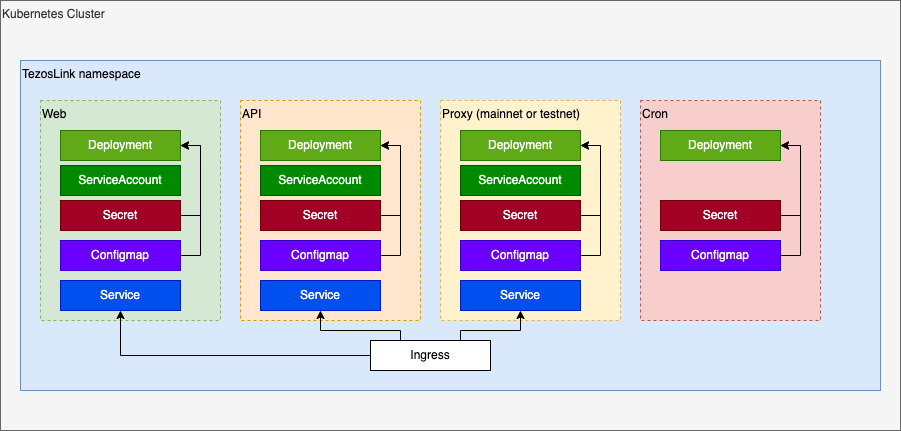tezosLink
TezosLink Community Kubernetes Helm Charts
Introduction
TezosLink provides a cutting-edge gateway to access the Tezos Network for dApps and bring the Tezos Link back from its ashes with an upgrade. It come along with a new dashboard with some key metrics to facilitate TezosLink usage and monitoring. With a turnkey solution and via Tezos K8s, thanks to oxheadalpha, it allows you to deploy a Tezos Node on a select cloud provider (AWS, GCP, Azure, Scaleway, etc …).
Architecture
(Schéma d’archi à rajouter)
Requirements
For a deployment on Cloud
You need: Kubernetes
Here are some official guides to get started with Kubernetes on Azure, AWS, GCP:
Tools
You need the following tools to install tezos-link :
- Helm CLI : Helm Installation
- Kubectl : Kubectl Installation
For a deployment on your local workspace
You need :
- minikube : Minikube
Deployments
The installation of TezosLink is composed of several different Helm charts :
For Postgres, a managed Postgresql instance can also be used.
Release version
| Helm charts | Version |
|---|---|
| tezos-k8s | x.x.x |
| tezoslink-proxy | x.x.x |
| bitnami/postgresql | 12.1.5 |
| tezoslink-api | x.x.x |
| bitnami/kube-prometheus | 8.3.2 |
Tezos-k8s deployment
TezosLink is based on Tezos node. Thanks to the Oxhead Alpha Community, who provide a clean Helm chart to deploy a node on Tezos, depending on your needs. To do so, you have to :
1. Add the Helm chart repository to your local Helm installation
helm repo add my-repo https://oxheadalpha.github.io/tezos-helm-charts/
2. Install the nodes
Before installing the node, you need to choose some pararmeters according to your needs. They are initialised in the
values.yml, located in tezos-k8s/charts/tezos
- The Tezos node version :
It’s the current version of Tezos, you’ll like to install. It can be any version, just make sure it’s officially available.
The variable name is :images: octez: tezos/tezos:v15-release - The protocol :
According to the Tezos version, the protocol must be specified.
Please refer to to the Tezos documentation to check the protocol name (command) linked to the Tezos version.
protocols:
- command: PtLimaPt
vote: {}
- The history mode :
This variable tells us the type of data we want to pull from the Tezos legder or the kind of request we are sending. Please refer to Tezos documentation for more detail. Due to Tezos Link dutties, we need to have not only an archive node, but also a rolling node.
Here’s an example of configuration to deploy both mode :
nodes:
rolling-node:
storage_size: 100Gi
runs:
- octez_node
instances:
- is_bootstrap_node: false
config:
shell:
history_mode: rolling
metrics_addr: [ "0.0.0.0:9932" ]
archive-node:
storage_size: 1000Gi
runs:
- octez_node
instances:
- is_bootstrap_node: false
config:
shell:
history_mode: archive
metrics_addr: [ "0.0.0.0:9932" ]
- The network :
It refers to either the testnet or the mainnet. Note that the mainnet’s name stills the same even if the protocol changes. The testnet must change according to one of the Tezos testnets in live. We decide to deploy a testnet and the mainnet :
node_config_network:
chain_name: mainnet
chain_name: limanet
- The snapshots datasources :
Thanks to Xtz-shots.io, who provides qualified snapshots of the ledger. For Tezos Link, we use :
archive_tarball_url: https://mainnet.xtz-shots.io/archive-tarball
archive_tarball_url: https://limanet.xtz-shots.io/archive-tarball
rolling_snapshot_url: https://mainnet.xtz-shots.io/rolling
rolling_snapshot_url: https://limanet.xtz-shots.io/rolling
Feel free to choose your snapshot provider.
Now that all the necessary variables are set, we can install the nodes.
We have two options:
a. either we clone the Tezos-K8s Repository and change the values according to our needs:
git clone https://github.com/oxheadalpha/tezos-k8s.git
cd tezos-k8s
We can access to tezos-k8s/charts/tezos/values.yml, to update the varaibles. And just run :
helm install <installation_name> charts/tezos --namespace <namespace> --create-namespace
b. either, after adding the oxheadalpha helm repository, directly deploy the nodes by setting the variables in the deploying command:
helm upgrade -i my-repo charts/tezos --version <refere to the release version section above> `
--create-namespace --namespace <namespace> `
--set images.octez="tezos/tezos:v15-release" `
--set protocols[0].command="PtLimaPt" `
...
Tezos-link Kubernetes resource map

Tezos-link installation
- Connect to your kubernetes cluster via kubectl command
- Create the following namespace :
kubectl create namespace tezos-link
- Deploy the Bitnami PostgreSQL Helm chart :
3.1 create the following secret for the postgresql root user and for the api user :
kubectl create secret generic -n tezos-link tezos-link-postgresql `
--from-literal=admin-password='Insert-a-strong-password' `
--from-literal=tezos-link-backend-password='Insert-a-strong-password'
3.2 Deploy the PostgreSQL helm chart provided by bitnami :
helm repo add my-repo https://charts.bitnami.com/bitnami
helm upgrade -i tezoslink-postgresql bitnami/postgresql --version <refere to the release version section above> `
--create-namespace --namespace tezoslink-postgresql `
--set global.postgresql.auth.username="tz-backend" `
--set global.postgresql.auth.database="tezoslink" `
--set global.postgresql.auth.existingSecret="tezoslink-postgresql" `
--set global.postgresql.auth.secretKeys.adminPasswordKey="admin-password" `
--set global.postgresql.auth.secretKeys.userPasswordKey="tz-backend-password"
3.3 Deploy Prometheus helm chart provided by bitnami :
helm upgrade -i kube-prometheus bitnami/kube-prometheus --version <refere to the release version section above> `
--create-namespace --namespace kube-prometheus `
--set alertmanager.enabled="false" `
--set blackboxExporter.enabled="false"
